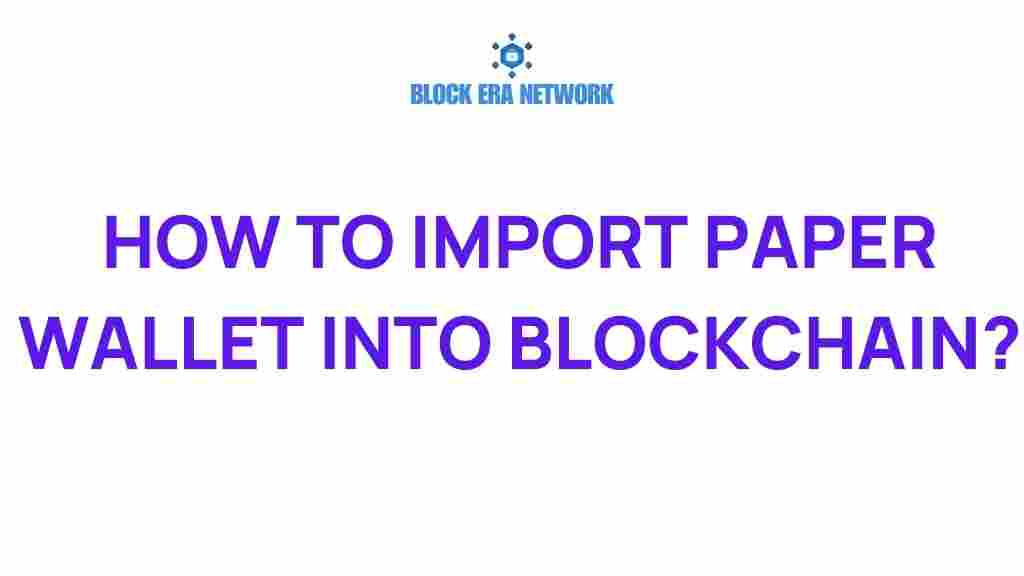Unlocking Your Crypto: Importing Your Paper Wallet into the Blockchain
As cryptocurrency continues to gain traction, managing your digital assets securely is more important than ever. One popular method of secure storage is using a paper wallet. This guide will walk you through the process of importing your paper wallet into the blockchain. We will cover everything from understanding the basics of blockchain technology to troubleshooting common issues that may arise during the wallet import process. Whether you’re a seasoned investor or just starting out, this user guide will ensure your crypto management is efficient and secure.
What is a Paper Wallet?
A paper wallet is a physical document that contains your cryptocurrency’s public and private keys. It is considered one of the safest ways to store digital assets because it is offline and immune to hacking. However, if you lose your paper wallet or if it gets damaged, you may lose access to your cryptocurrency.
Understanding Blockchain and Cryptocurrency
The blockchain is a decentralized ledger that records all transactions across a network of computers. Each transaction is grouped into blocks and added to a chain, ensuring transparency and security. Cryptocurrencies are digital or virtual currencies that use cryptography for security, making them difficult to counterfeit. The most popular cryptocurrency is Bitcoin, but there are thousands of others, each with unique features.
Why Use a Paper Wallet?
- Secure Storage: Since a paper wallet is not connected to the internet, it is less susceptible to hacking.
- Complete Control: You have complete control over your private keys, eliminating reliance on third-party services.
- Cost-effective: Creating a paper wallet is free, which makes it an attractive option for many users.
Step-by-Step Process to Import Your Paper Wallet into the Blockchain
Now that you understand what a paper wallet is and why it’s beneficial, let’s dive into the step-by-step process of importing your paper wallet into the blockchain.
Step 1: Access a Reliable Wallet
Before you can import your paper wallet, you need a reliable cryptocurrency wallet that supports the coins you are importing. Some popular wallets include:
Step 2: Locate Your Private Key
Your paper wallet contains a private key, which is crucial for accessing your funds. It may be printed as a QR code or in text format. Make sure you have clear access to this key.
Step 3: Open Your Wallet Import Feature
In your chosen wallet, locate the option to import a wallet or add funds. This feature is often labeled as “Import Wallet,” “Restore Wallet,” or something similar.
Step 4: Enter Your Private Key
Input your private key from the paper wallet into the corresponding field. If your wallet supports QR code scanning, you may also scan the QR code if available.
Step 5: Confirm and Complete the Import
Once you’ve entered your private key, confirm the operation. Your wallet will now synchronize with the blockchain, updating your balance to reflect the funds from your paper wallet.
Step 6: Secure Your Wallet
After importing your paper wallet, it’s essential to secure your new wallet. Consider setting up two-factor authentication (2FA) and keeping backups of your wallet information.
Troubleshooting Common Issues
Here are some common issues you might encounter when importing your paper wallet and how to resolve them:
- Invalid Private Key: Ensure you have entered the private key correctly. Even a single character off can result in an error.
- Wallet Not Supporting Your Coin: Make sure the wallet you are using supports the cryptocurrency associated with your paper wallet.
- Network Issues: If the wallet fails to sync, check your internet connection and try again later.
Secure Storage of Digital Assets
After importing your paper wallet, consider the following tips for secure storage of your digital assets:
- Hardware Wallets: For long-term storage, consider investing in a hardware wallet, which provides an extra layer of security.
- Regular Backups: Always maintain backups of your private keys and wallet information, especially if you change wallets.
- Stay Informed: Keep up to date with the latest security practices and threats in the cryptocurrency space.
Conclusion
Importing a paper wallet into the blockchain is a straightforward process that can provide you with access to your digital assets while ensuring secure storage. By following the steps outlined in this guide, you can successfully manage your cryptocurrency while minimizing the risks associated with online storage. Remember, your private keys are the gateway to your assets; treat them with the utmost care. For more information on managing your crypto assets, check out our detailed user guide on cryptocurrency security.
In summary, a paper wallet is an effective way to store your cryptocurrencies securely, and understanding how to import it into a wallet will enhance your crypto management skills. Always prioritize security, stay informed, and enjoy your journey in the world of digital assets!
This article is in the category Crypto Security and created by Block Era Network Team
